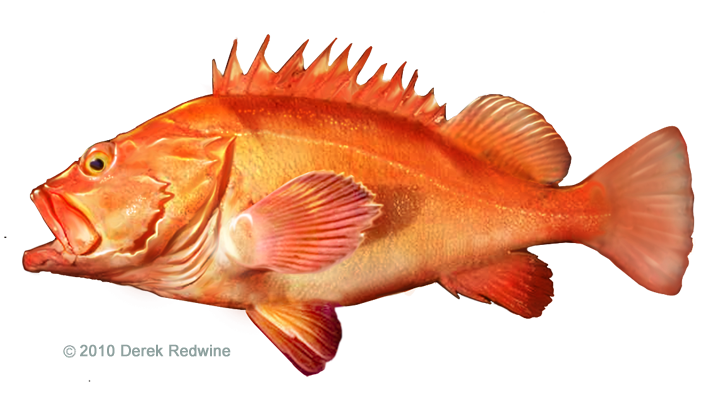Game Fish Identification Reference Guides
Rockfish, yelloweye
(Sebastes ruberrimus)
(Sebastes ruberrimus)

(Jordan & Gilbert 1883); SCORPAENIDAE (SEBASTIDAE) FAMILY; also called red snapper, rasphead rockfish, turkey-red rockfish
Occurs in the eastern Pacific from the Gulf of Alaska to northern Baja California, Mexico where it inhabits rocky reefs and boulder fields in 60 to 1800 feet (46 –550 m) where they seek shelter in caves and crevices.
Although the yelloweye rockfish is know to many anglers as “red snapper” it is not related. It is one of the many red species of rockfishes in the eastern Pacific. Similar species include the canary and vermilion rockfishes but both have red eyes and different coloration. The body of a yelloweye rockfish is orange red to orange yellow and the fins may be black at the edges. Adults usually have light to white lateral lines. The eye is brilliant yellow. Raspy head spines are present in adult yelloweye rockfish. Juvenile coloration is so different that they were once described as a separate species. Juveniles have a rather dark background with a light stripe along the whole lateral line to the base of the caudal fin where the stripe divides at right angles to surround the caudal peduncle. A second, shorter line is found below the lateral line.
Like most rockfishes, yelloweye rockfish are most often landed in deep water by anglers bottom-fishing. Because they are found at great depth, heavy weights are used to present the baits and jigs. Because or their size, yelloweyes are one of the largest rockfishes, beautiful coloration infrequently landing, they are one of the most prized of all “bottomfishes.”
The delicate white flesh of this rockfish make it a favorite of seafood eating anglers. With a lower oil content than other rockfishes, the yelloweye rockfish is particularly delicious deep-fried
Occurs in the eastern Pacific from the Gulf of Alaska to northern Baja California, Mexico where it inhabits rocky reefs and boulder fields in 60 to 1800 feet (46 –550 m) where they seek shelter in caves and crevices.
Although the yelloweye rockfish is know to many anglers as “red snapper” it is not related. It is one of the many red species of rockfishes in the eastern Pacific. Similar species include the canary and vermilion rockfishes but both have red eyes and different coloration. The body of a yelloweye rockfish is orange red to orange yellow and the fins may be black at the edges. Adults usually have light to white lateral lines. The eye is brilliant yellow. Raspy head spines are present in adult yelloweye rockfish. Juvenile coloration is so different that they were once described as a separate species. Juveniles have a rather dark background with a light stripe along the whole lateral line to the base of the caudal fin where the stripe divides at right angles to surround the caudal peduncle. A second, shorter line is found below the lateral line.
Like most rockfishes, yelloweye rockfish are most often landed in deep water by anglers bottom-fishing. Because they are found at great depth, heavy weights are used to present the baits and jigs. Because or their size, yelloweyes are one of the largest rockfishes, beautiful coloration infrequently landing, they are one of the most prized of all “bottomfishes.”
The delicate white flesh of this rockfish make it a favorite of seafood eating anglers. With a lower oil content than other rockfishes, the yelloweye rockfish is particularly delicious deep-fried












